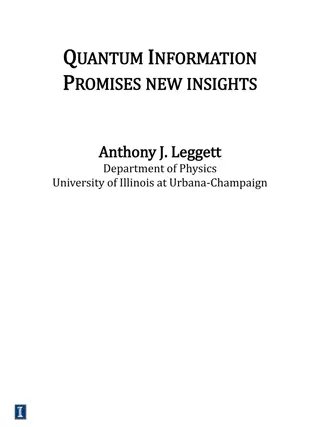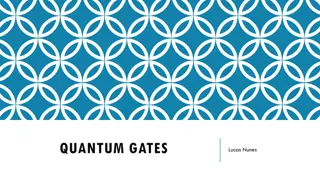Advancements in Quantum Systems Techniques for Density Matrix Minimization
Discover the innovative methods and applications of open quantum systems techniques for density matrix minimization. Explore the motivation behind the research, early developments, purification processes, linear scaling potentials, Bloch's method intricacies, quantum channel algorithms, canonical density matrix updates, and Huckel theory implications in quantum systems.
Download Presentation

Please find below an Image/Link to download the presentation.
The content on the website is provided AS IS for your information and personal use only. It may not be sold, licensed, or shared on other websites without obtaining consent from the author.If you encounter any issues during the download, it is possible that the publisher has removed the file from their server.
You are allowed to download the files provided on this website for personal or commercial use, subject to the condition that they are used lawfully. All files are the property of their respective owners.
The content on the website is provided AS IS for your information and personal use only. It may not be sold, licensed, or shared on other websites without obtaining consent from the author.
E N D
Presentation Transcript
Applying Open Quantum Systems Techniques to Density Matrix Minimization JACOB LEAMER TULANE UNIVERSITY
Early DMM LNV Daw 1 ? = ??[ ? ?] ? = ??[ ? ?] ? = 1 + exp ? ? ? 1 = ??[ ? ? ? 1 ] ? ? ?? ? ??
Blochs Method ? = ? ? ?, ? 0 = 1 ? ? ??= ?? ? ? ??= 1 ? ? 1 2 ? ? 2
Blochs Method Let us consider the derivative more closely: ? ? + ?? ? ? ?? = 1 ? ? 1 2 ? ? + ?(??) 2 ? ? + ?? = ? ?? ? ? ?? ? ? + ?(??2) 2 2 ?(? + ??) = (1 ?? ?) ?(1 ?? ?) + ?(??2) 2 2
Our DMM 1 ? = 1 + ??( ? ?), ? 0 = 1 ? ? ??= 1 + ?? ? ? ? ? ?? = ?(1 ?)( ? ?) 2?? ? ? ? ? ? ? ??= 1 ? ? 1 ? ? 1 ? ? 2 ? 1 ? 2
Our DMM Let us consider the derivative more closely: ? ? + ?? ? ? ?? = 1 ? ? 1 ? ? 1 ? ? + ?(??) 2 ? 1 ? 2 ? ? + ?? = ? ?? ? ? 1 ? ? ?? ? ? + ?(??2) ? 1 ? 2 2 ? ? + ?? = 1 ?? ? 1 ?? ? ? 1 ? ? ? 1 ? + ?(??2) 2 2
Quantum Channel Algorithm ?? ??+1
Canonical DMM Need to update at every step according to: ? =?? ? ? 1 ? ??[ ? 1 ? ] Additionally, ?? 1 ? 0 = ?? 1 where ?? is the number of electrons in the system
Huckel Theory ? ? 0 0 0 0 ? ? ? 0 0 0 0 ? ? ? 0 0 0 0 ? ? ? 0 0 0 0 ? ? ? 0 0 0 0 ? ? ? = For ethylene, ? = 11.4 ?? and ? = 65 ????/???
Our DMM applied to mu 1 ? = 1 + ??( ? ?), ? 0 = 1 ? ? ??= 1 + ?? ? ? 2?? ? ?( ?) ? ? ?? = ? ?(1 ?) 1 ? ? +? ? ? ??=? 2 ? 1 ? + ?(??) 2 ? ? + ?? = 1 +??? ? 1 +??? + ?(??2) 1 ? 1 ? 2 2
Conclusion Several goals for the future of this project: Find more realistic models to implement Adopt a non-orthogonal basis version for more general use (very important if we want to compare with DFT methods) Fine tune the code to achieve the maximum speed possible
References Akimov, Alexey V., and Oleg V. Prezhdo. Large-Scale Computations in Chemistry: A Bird s Eye View of a Vibrant Field. Chemical Reviews 115, no. 12 (June 24, 2015): 5797 5890. https://doi.org/10.1021/cr500524c. Challacombe, Matt. A Simplified Density Matrix Minimization for Linear Scaling Self-Consistent Field Theory. The Journal of Chemical Physics 110, no. 5 (February 1999): 2332 42. https://doi.org/10.1063/1.477969. Palser, Adam H. R., and David E. Manolopoulos. Canonical Purification of the Density Matrix in Electronic-Structure Theory. Physical Review B 58, no. 19 (November 15, 1998): 12704 11. https://doi.org/10.1103/PhysRevB.58.12704.
References Li, X.-P., R. W. Nunes, and David Vanderbilt. Density-Matrix Electronic-Structure Method with Linear System-Size Scaling. Physical Review B 47, no. 16 (April 15, 1993): 10891 94. https://doi.org/10.1103/PhysRevB.47.10891. Daw, Murray S. Model for Energetics of Solids Based on the Density Matrix. Physical Review B 47, no. 16 (April 15, 1993): 10895 98. https://doi.org/10.1103/PhysRevB.47.10895.























